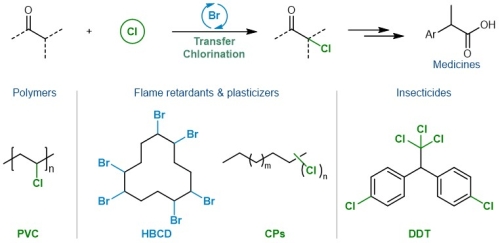Halogenated organic pollutants (HOPs), produced by extensively using halogenated compounds, damage the environment. The repurposing of HOPs offers a means of pollution abatement and reduces greenhouse gas emissions.
The utility of HOPs, especially halogens in HOPs, is limited due to the challenge of direct chlorination of C–H bonds in HOPs.
Recently, a research group led by Prof. CHEN Qingan from the Dalian Institute of Chemical Physics (DICP) of the Chinese Academy of Sciences (CAS) has realized the reuse of HOPs. They developed a bromide-catalyzed chlorine transfer reaction, which utilized HOPs as halogen sources, thereby enabling the reuse of various HOPs. This study was published in Nature Chemistry.

Repurposing of halogenated organic pollutants via alkyl bromide-catalysed transfer chlorination (Image by LIU Heng)
The developed strategy realized the repurposing of HOPs via alkyl bromide-catalysed transfer chlorination. It enabled the chlorination of ketones and facilitated the chlorohydroxylation of olefins via the chlorine-transfer reaction.
The researchers found that the reaction proceeded through a halogen-exchange process, facilitating chlorine transfer between distinct molecules. Therefore, they realized the diversified use of the brominated pollutant hexabromocyclododecane (HBCD).
In addition, the researchers indicated that this strategy could repurpose a variety of chlorinated organic pollutants, including chlorinated paraffins (CPs), dichlorodiphenyltrichloroethane (DDT), chloromethyl polystyrene (CMPS) and poly(vinyl chloride) (PVC). The practical value of this reaction was further shown by synthesizing three pharmaceuticals and reusing PVC waste.
"Our study demonstrated that transfer chlorination could be facilitated by alkyl bromide catalysis, and the developed strategy will promote the development of transforming waste into value-added products," said Prof. CHEN.
The research was supported by DICP, the Dalian Outstanding Young Scientific Talent, and the National Natural Science Foundation of China. (Text by LIU Heng)